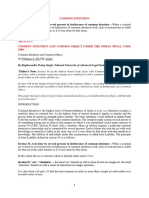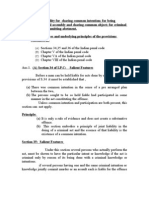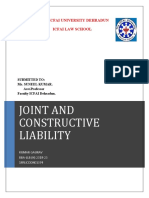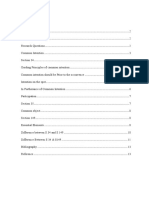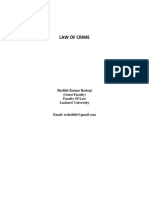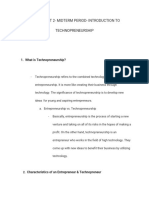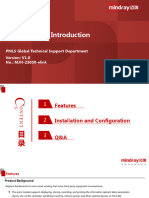Chapter 6
Chapter 6
Uploaded by
divvyaapCopyright:
Available Formats
Chapter 6
Chapter 6
Uploaded by
divvyaapOriginal Title
Copyright
Available Formats
Share this document
Did you find this document useful?
Is this content inappropriate?
Copyright:
Available Formats
Chapter 6
Chapter 6
Uploaded by
divvyaapCopyright:
Available Formats
Chapter 6
JOINT LIABILITY
The law relating to joint liability or group liability has been elaborately dealt with and covered by sections 34, 149, 120A
and 120B of the Code. The doctrine of combination in crime is, that when two or more persons unite to accomplish a
criminal object, whether through the physical volition of one, or proceeding severally or collectively, each individual
whose win contributed to the wrong doing is in law responsible for the whole, the same as though performed by himself
alone1.
JOINT LIABILITY UNDER SECTION 34, I.P.C.
Discuss the essentials of group liability under section 34, I.P.C.
Section 34, I.P.C. says:
34. Acts done by several persons in furtherance of common intention
When a criminal act is done by several persons in furtherance of the common intention of all, each of such persons is
liable for that act in the same manner as if it were done by him alone.
Section 34 of the Code creates no specific offence. It only intends to cover situations in which a criminal act is
committed by several persons; and it is not easy to demarcate the extent and quantum of participation by each one of
such several persons. In such a situation it was considered proper that all such persons be declared liable for the
criminal act done by them jointly. This section embodies the principle of joint liability in the doing of criminal act, the
essence of joint liability being the existence of a 'common intention'.
'Common intention' should not be confused with 'similar intention'; it means 'intention common to all. To come within the
mischief of this section the following ingredients must be present:
(a) there must be a common intention to commit a crime;
(b) such act must be committed in furtherance of the common intention; (c) such act must result in the
commission of a crime;
(d) such common intention must be common to two or more persons;
(e) such persons (more than two or more) must have done the act or must have participated in the commission
of that act.
______________
1. Bishop's Com m entaries on Crim inal Law (Vol. 1).
Object of the section
Discuss the meaning and scope of the word 'common intention' as used in section 34 of the I.P.C.
Section 34 has been enacted on the principle of joint liability in the doing of a criminal act. The section is only a rule of
evidence and does not create a substantive offence. The distinctive feature of the section is the element of
participation in action. The liability of one person for an offence committed by another in the course of criminal act
perpetrated by several persons arises under section 34 if such criminal act is done in furtherance of a common intention
of the persons who join in committing the crime. Direct proof of common intention is seldom available and, therefore,
such intention can only be inferred from the circumstances appearing from the proved facts of the case and the proved
circumstances. In order to bring home the charge of common intention, the prosecution has to establish by evidence,
whether direct or circumstantial, that there was a plan or meeting of minds of all the accused persons to commit the
30-05-2024 (Page 1 of 11) www.manupatra.com Symbiosis Law School
offence for which they are charged with the aid of section 34, be it prearranged or on the spur of the moment; but it
must necessarily be before the commission of the crime. The true contents of the section are that if two or more
persons intentionally do an act jointly, the position in law is just the same as if each of them has done it individually by
himself; Harbans Singh v. State of Haryana, MANU/SC/0170/2005 : AIR 2005 SC 2989.
Guiding principles of 'common intention'
Discuss the guiding principles of common intention as laid down by the Penal Code in Mahboob Shah v. Emperor
In Mahboob Shah v. Emperor, 721 IA 148 (PC): MANU/PR/0013/1945 : AIR 1945 PC 118 the following principles were laid
down by the court:
(i) Under section 34 of the Penal Code, essence of liability is to be found in the existence of a common intention,
animating the accused, leading to the doing of a criminal act in furtherance of such intention.
(ii) To invoke the aid of section 34 successfully, it must be shown that the Criminal act complained against was
done by one of the accused persons in furtherance of the common intention; if this is so then liability for the
crime may be imposed on any one of the persons in the same manner as if the acts were done by him alone.
(iii) Common intention within the meaning of section 34 implies a prearranged plan, and to convict the accused of
an offence applying the section it should be proved that the criminal act was done pursuant to the prearranged
plan.
(iv) It is difficult, if not impossible, to procure direct evidence to prove the intention of an individual, in most
cases it has to be inferred from his act or conduct or other relevant circumstances of the case.
(v) Care must be taken not to confuse same or similar intention with common intention; the partition which
divides "their bounds" is often very thin; nevertheless, the distinction is real and substantial and if overlooked will
result in miscarriage of justice.
(vi) The inference of common intention within the meaning of the term under section 34 should never be reached
unless it is a necessary inference deductible from the circumstances of the case.
'Common intention' is a matter of interference
In Jai Bhagwan v. State of Haryana, 1999 Cr LJ 1634 (SC) it was held that to apply section 34, I.P.C., apart from the
fact that there should be two or more accused, two factors must be established:--
(i) Common intention, and
(ii) Participation of the accused in the commission of an offence. If the common intention is proved but no overt
act is attributed to the individual accused, section 34 will be attracted as essentially it involves vicarious liability,
but if participation of the accused in crime is proved and common intention is absent, section 34 cannot be
invoked. In every case it is not possible to have direct evidence of common intention. It has to be inferred from
the facts and circumstances of each case.
In furtherance of common intention
What is meant by further of common intention discuss in light of Mahboob Shah v. Emperor?
The principle of joint-liability arises out of common intention followed by an act in furtherance of such common intention.
This is clearly illustrated by the well-known case Mahboob Shah v. Emperor, 721 IA 148 (PC): MANU/PR/0013/1945 : AIR
1945 PC 118, wherein one Allah Dad was shot dead by a bullet from the gun used by one of the accused who came to
rescue their cousin who had been attacked by Allah Dad and shouted for help. The two accused were armed with guns,
and each one of them aimed at two different individuals shot from the gun of Wali Shah, the latter only received injuries
from a bullet shot by Mahboob Shah. (See the case in detail, infra). Of the three accused, Wali Shah, whose shot killed
30-05-2024 (Page 2 of 11) www.manupatra.com Symbiosis Law School
Allah Dad absconded and could not be brought to trial, and the other two were prosecuted for murder under section 302
read with section 34, I.P.C. The Sessions Judge convicted him of the offence and sentenced him to death. On appeal,
their Lordships of the Lahore High Court held that the case fell within the ambit of section 34, and as to their "common
intention", it was said that "common intention to commit the crime which was eventually committed by Mahboob Shah
and Wali Shah came into being when Ghulam Qasim Shah shouted to his companions to come to his rescue and both of
them emerged from behind the bushes and fired from their respective guns."
Their Lordships of the Privy Council however disagreed with the view of the judges of the High Court. In their opinion
there was no evidence of common intention to the evidence that the appellant "just have been acting in concert with
Wali Shah pursuance of a concerted plan when he along with him rushed to the help of Ghulam Qasim". In their view the
common intention of both was to rescue Ghulam Qasim and both of them picked up different individuals to deal with.
Evidence is lacking to show that there was any pre-mediation to bring about the murder of Allah Dad. At the most, they
can be stated to have "similar intention but similar intention is different from 'common intention' and one should not be
confused with the other.
Their Lordships, therefore, set aside the conviction and sentence of the offence of murder imposed by the High Court.
Prior intention to commit murder
In Vithal Laxman Chalawadi v. State of Karnataka, MANU/SC/0861/2010 : AIR 2011 SC 173, the Supreme Court held that
where the appellant with two person objected to construction of drain. Evidence shown that three appellants armed
with gandasi and other two with dangs caused injuries to deceased. Evidence of Doctor proved
that accused had used blunt side of Gandasi. So prior intention confirmed. Appeal dismissed and Supreme Court upheld
the life imprisonment which was given by the High Court.
In Satyavir Singh Rathi v. State, MANU/SC/0546/2011 : AIR 2011 SC 1748 the Supreme Court held that where the police
officials killed innocent victims on account of common intention to kill a hard core wanted criminal without any identity
as criminals. Specific role to each individual accused police party as the firing at car was undoubtedly with a clear intent
to annihilate those. No appeal by state against deemed acquitted for offence under section 302/307, 34. The
modification of conviction to one under 302/307, 34 by High Court is proper. In furtherance of the common intention of
all accused police officials liable to conviction under section 300/34.
Common intention should be prior to the occurrence
Discuss what makes the common intention punishable under law
Discuss the Pandurang's case briefly
In Pandurang v. State of Hyderabad, MANU/SC/0048/1954 : AIR 1955 SC 216: 1955 Cr LJ 572 their Lordships of the
Supreme Court observed that it is well established that a common intention presupposes prior concert. It requires a pre-
arranged plan because before a person can be vicariously convicted for the crirninal act of another, the act must have
been done in furtherance of the common intention of them all. The inference of common intention should never be
reached unless it is a necessary inference deducible from the circumstances of the case. The incriminating facts must be
incompatible with the innocence of the accused and incapable of explanation on any other reasonable hypothesis.
In State of Uttar Pradesh v. Rohan Singh, 1996 Cr LJ 2884 (SC) the Supreme Court relied on the view of this court in
Pandurang v. State of Hyderabad, MANU/SC/0048/1954 : AIR 1955 SC 216: 1955 Cr LJ 572, and observed that:
"Common intention necessarily implies a pre-arranged plan or prior concert or prior meetings of minds. Thus there is a
sharing of the purpose, which is lacking in a case where several persons have the 'same or similar intention'. Several
persons can simultaneously attack a man and each can have the same intention, namely, the intention to kill, and each
can individually inflict a separate fatal blow and yet none would have the common intention required by the section
because there was no prior meeting of minds to form a pre-arranged plan".
30-05-2024 (Page 3 of 11) www.manupatra.com Symbiosis Law School
Joint-liability in context of free fight
Discuss the application of joint liability in context of free fight in the light of Balbir Singh case
The issue of liability of different members of a group of people divided into mutually antagonistic or hostile groups,
especially when there is free fight between them, is one of the most difficult aspects of joint-liability. In Balbir Singh v.
State of Punjab, MANU/SC/0385/1995 : AIR 1995 SC 1956 a similar question was raised, wherein four persons, each
belonging to two groups attacked each other and in the result one person died. Both the trial court and the High Court
had held that there was a free fight and every assailant was accountable for his own individual acts committed.
However, the Supreme Court held that, in a free fight, there was a movement of body of the victims and assailants and
in such a situation it will be difficult to specifically ascribe to one accused the intention to cause injuries sufficient to
cause death.
Participation
Participation is a necessary element or condition precedent to a finding of joint-liability. The Supreme Court in Kantian
Ramayya Munipally v. State of
Bombay, MANU/SC/0050/1954 : AIR 1955 SC 287 observed that, it is the essence of the section 34 that the person
must be physically present at the actual commission of the crime. He need not be present in the actual spot, he can, for
instance, stand guard by a gate outside ready to warn his companions about any approach of danger or wait in a car on
a nearby road ready to facilitate their escape, but he must be physically present at the scene of the occurrence and
must actually participate in the commission of the offence in some way or the other at the time the crime is actually
committed.
JOINT-LIABILITY UNDER SECTION 149, I.P.C.
Discuss the principle which depreciate the section 34 with section 149
Section 149, I.P.C. provides:
149. Every member of unlawful assembly guilty of offence committed in prosecution of common object
If an offence is committed by any member of an unlawful assembly in prosecution of the common object of that
assembly, or such as the members of that assembly knew to be likely to be committed in prosecution of that object,
every person who, at the time of the committing of that offence, is a member of the same assembly, is guilty of that
offence.
This section covers such cases in which several members of an unlawful assembly may be held guilty of an offence if
their 'object' is the same though all of them may not have actually participated in doing of that act.
Essential ingredients
Discuss the essential ingredients of section 149
To invoke section 149, I.P.C., the following ingredients must be present:
(a) There must be an unlawful assembly. What is an unlawful assembly has been explained below;
(b) There must be five or more persons forming such an unlawful assembly;
(c) There must be some common object of such an unlawful assembly. Here the word "common" must be
distinguished from "similar"; it means "common to all and known to the rest of them and also shared by them".
(d) There must be a commission of an offence by anyone or more members of such unlawful assembly.
(e) The commission of such offence by anyone or more members of such unlawful assembly must be in the
30-05-2024 (Page 4 of 11) www.manupatra.com Symbiosis Law School
prosecution of the common object shared by all and each one of the members of such unlawful assembly;
(f) The offence committed in prosecution of a common object must be such that each one of the members of
such unlawful assembly knew was likely to be committed in the prosecution of the common object.
Unlawful assembly: meaning of
Section 141, I.P.C. defines for 'unlawful assembly' in the following words:
In Sajjan Sharma v. State of Bihar, MANU/SC/0020/2011 : AIR 2011 SC 632, the Supreme Court held that where firing by
unlawful assembly on a villager. Appellant lives in same village as informant but no name in FIR. Appellant's father and
brother who seenas members of unlawful assembly were named in FIR. Appellant identified at time of incident but no
particular role assigned. Evidence of witness also as one of members of unlawful assembly. Court can't relied upon
evidence so appellant acquitted giving benefit of doubt.
In Shaji v. State of Kerala, MANU/SC/0544/2011 : AIR 2011 SC 1825, the Supreme Court held that where Murder
committed by members of unlawful assembly with arms. Medical evidence showing that injury caused by that member
was fatal. All members were not armed. So insufficient to prove common object. Conviction of other accused with aid of
section 149 were Improper.
141. Unlawful assembly
Discuss the principle of Mizaji v. State of Uttar Pradeeh
Will your answer be different if the court acquitted X and Y on the ground that their presence in the group was not
clearly established?
An assembly of five or more persons is designated an "unlawful assembly", if the common object of the persons
composing that assembly is--
First- To overawe by criminal force, or show of criminal force, the Central or any State
Government or Parliament or the Legislature of any State, or any public servant in the
exercise of the lawful power of such public servant; or
Second.- To resist the execution of any law, or of any legal process; or
-
Third.-- To commit any mischief or criminal trespass, or other offence; or
Fourth.- By means of criminal force, or show of criminal force, to any person, to take or obtain
- possession of any property, or to deprive any person of the enjoyment of a right of
way, or of the use of water or other incorporeal right of which he is in possession or
enjoyment, or to enforce any right or supposed right; or
Fifth.-- By means of criminal force, or show of criminal force, to compel any person to do what
he is not legally bound to do, or to omit to do what he is legally entitled to do.
Explanation.--
An assembly which was not unlawful when it assembled, may subsequently become an unlawful assembly.
An assembly of five or more than five persons, combined for one or the other purposes indicated in section
141, is declared in law an 'lawful assembly'.
In Mizaji v. State of Uttar Pradesh, MANU/SC/0040/1958 : AIR 1959 SC 572 it was held that section 149 has two parts.
The liability of a member of an unlawful assembly may arise for an offence committed by any member of the assembly in
two ways. The first is where the other member commits an offence, which was in fact the object of the assembly. The
30-05-2024 (Page 5 of 11) www.manupatra.com Symbiosis Law School
second is where the common object to commit an offence was different from the offence which was actually committed:
(a) The accused X, Y, Z, J and K were alleged to have entered into A's house in order to get forceable
possession of the house. With the lathis they were carrying, grave injuries were inflicted on A's limb and he was
dragged out of his house to some distance where either J or K shot him dead with a hidden pistol. Advise on the
group liability of the persons involved in the case.
(b) A, B, C, D and E armed with a handgun, a spear, a lathi, a sword, and a knife respectively with the common
object of taking forcible possessionof land from M, N or 0 enter on the land in their possession. The latter who
are in possession try to checkmate instruction and in the fight A alone fires and O is killed. Decide the liability of
A, E, C, D and E for the killing of O and refer to precedents.
In such a case the member not actually committing the offence will be liable for that offence only if he knew that such
offence was likely to be committed in the course of the prosecution of the common object to commit the offence
originally thought of.
The expression "know" does not mean a mere possibility, such as might or might not happen, it imports a high degree of
probability. Further, it indicates a state of mind at the time of the commission of the offence and not the knowledge
acquired in the light of subsequent events. Under section 149, the liability of the other members for the offence
committed during the continuance of the occurrence rests upon the fact whether the other members knew before hand
that the offence actually committed was likely to be committed in prosecution of the common object. Such knowledge
may reasonably be collected from the nature of the assembly, arms or behaviour, at or before the scene of action;
Gajanand v. State of Uttar Pradesh, MANU/SC/0173/1954 : AIR 1954 SC 695.
Common object: Meaning of
Discuss the meaning of expression "common object"
Section 149 of Indian Penal Code postulates an assembly of five or more persons having a common object i.e., one of
those named in section 141, I.P.C. and then doing of the act as by the members of it in prosecution of that object. The
basis of constructive guilt under section 149 is mere membership of an unlawful assembly. Under section 149, if the
accused is a member of an unlawful assembly, the common object of which is to commit a certain crime, and such a
crime is committed by one or more of the members of that assembly, every person who happens to be a member of that
assembly would be liable for the commission of the crime being a member of it irrespective of the fact whether he has
actually committed the criminal act or not. There is a distinction between the common object and common intention.
The common object need not require prior concert and a common meeting of minds before the attack, and an unlawful
object can develop after the assembly gathered before the commission of the crime at the spot itself. There need not
be prior meeting of the mind. It would be enough that the members of the assembly which constitutes five or more
persons, have common object and that they acted as an assembly to achieve that object. In substance, section 149
makes every member of the common unlawful assembly responsible as a member for the act of each and all, merely
because he is a member of the unlawful assembly with common object to be achieved by such an unlawful assembly. At
the same time, one has to keep in mind that mere presence in the unlawful assembly cannot render a person liable
unless there was a common object and that is shared by that person. The common object has to be found and can be
gathered from the facts and circumstances of each case; Rabindra Mahto v. State of Jharkhand, I (2006) CCR 44 (SC).
Section 34 and section 149 distinguished
Discuss the features which distinguished section 34 with 149 I.P.C.
Though sections 34 and 149, I.P.C. seem to overlap, yet there is a marked difference between the two.
(a) Section 34 does not create an offence, it merely lays down a rule of law; section 149 creates a definite offence and
deals with the punishment of that offence alone. Thus being a member of unlawful assembly is by itself an offence.
30-05-2024 (Page 6 of 11) www.manupatra.com Symbiosis Law School
(b) Under section 34 common intention is the decisive test, whereas in section 149 common object of the members of an
unlawful assembly must be established.
(c) Participation or presence in the criminal act is essential to fix liability under section 34. Membership (not necessarily
presence) is the foundation of the liability under section 149.
(d) Section 34 requires two or more persons involved in the commission of the offence. Section 149 requires five or more
persons of an unlawful assembly in the commission of an offence.
(e) Section 34 provides for 'common intention' which requires a preconcerted plan or agreement; whereas section 149
speaks about 'common object' does not necessarily require any pre-concert.
CONSPIRACY
A criminal conspiracy is the agreement of two or more persons to do an illegal act or to do a legal act by illegal means.
Sections 120A and 120B, I.P.C. deal with criminal conspiracy. While section 120A defines 'crirninal conspiracy', section
120B provides punishment for this offence.
Section 120A reads:
120A. Definition of criminal conspiracy
Discuss the principle laid down in section 120A of the I.P.C.
Discuss the ratio of Nalini's case
When two or more persons agree to do, or cause to be done,--
(1) an illegal act, or
(2) an act which is not illegal by illegal means, such an agreement is designated a criminal conspiracy:
Provided that no agreement except an agreement to commit an offence shall amount to a criminal
conspiracy unless some act besides the agreement is done by one or more parties to such agreement in
pursuance thereof.
Explanation.--
It is immaterial whether the illegal act is the ultimate object of such agreement, or is merely
incidental to that object.
In Sushil Suri v. CBI, MANU/SC/0563/2011 : AIR 2011 SC 1713, the Supreme Court held that where two Chartered
Accountants had dishonestly and fraudulently opened several fictitious accounts in some banks with an intention and
object to facilitate of bank finance for the purpose other than stated in the loan application. Accused persons submitted
to the bank, fake and forged invoices of fictitious/non-existent supplier. Essential ingredient of criminal conspiracy is
agreement to commit offence between accused. Commission of crime alone enough to bring about a conviction under
section 120B. Appellant with Directors and Chartered Accountant defrauded revenue and in the process cheated the
public exchequer of crores of rupees and were convicted under section 120B, 420, 409, 471 of IPC.
In State (C.B.I./S.I.T.) v. Nalini, (1999) 5 Supreme 60 (Rajiv Gandhi murder case) the apex Court held that an
agreement between two or more persons to do an illegal act amounts to criminal conspiracy. The illegal act may or may
notbe done in pursuance of the agreement but the very agreement is an offence and is punishable. Everyone of the
conspirator need not have taken active part in the commission of each and every one of the conspiratorial acts for the
offence of conspiracy to be made out. The prosecution need not necessarily prove what the perpetrators expressly
agreed to do and/or caused to be done the illegal act. The agreement may be proved by necessary implication, under
section 120B, I.P.C. In the impugned case the accused were charged and convicted under section 120B read with
30-05-2024 (Page 7 of 11) www.manupatra.com Symbiosis Law School
section 302, I.P.C. by the designated Court. The accused appealed to the apex Court to set aside the conviction.
Essential ingredients
Discuss the essentials of section 120A, I.P.C.
The ingredients of section 120A, I.P.C. are as stated below:
(1) There should be an agreement between two or more persons who are alleged to conspire;
(2) The agreement should be to do or cause to be done:
(i) an illegal act 1, or
(ii) an act which may not itself be illegal but be done by illegal means.
Illegal act: Meaning of
The word 'illegal' is defined in section 43 of the Code as 'applicable to everything which is an offence, or which is
prohibited by law, or which furnishes ground for a civil action'; and a person is said to be 'legally bound to do whatever it
is illegal in him to omit'.
Reading sections 43 and 120A together it would appear that two or more persons would be guilty of a criminal
conspiracy whenever they agree to do or cause to be done acts, which are an offence punishable under the Indian
Penal Code or any special or local law, or which are prohibited by law, or which furnish ground for civil action. Leaving
the case of punishable offences or other acts prohibited by law aside, acts which might furnish ground for a civil action
may be either (a) breaches of contract, or (b) wrongs independent of contract, committed by an individual acting alone
or by two or more persons acting in combination. A wrongful act must necessarily be so in two or more acting in
concert.
In Bimbadhar Pradhan v. State of Orissa, MANU/SC/0024/1956 : AIR 1956 SC 469 the apex Court observed that, it is not
necessary that each one of the conspirators should be aware of the acts done by any of conspirators during the course
of the conspiracy. The acts done by any of conspirators in furtherance of the purpose the conspiracy are relevant as
merely indicative of what the object of the conspiracy was. What is relevant is that there should be one conspiracy to
which specific persons were parties and not series or conspiracies, for the liability of each conspirator has to be fixed in
relation to the particular conspiracy entered into by him with the others.
PUNISHMENT FOR 'CRIMINAL CONSPIRACY'
Section 120B punishes for the offence of 'criminal conspiracy' in the following manner:
____________
1. See section 43 for definition of 'act'.
120B. Punishment of criminal conspiracy
Discuss the difference between 120 & 120B of I.P.C.
(1) Whoever is a party to a criminal conspiracy to commit an offence punishable with death, imprisonment for life or
rigorous imprisonment for a term of two years or upwards, shall, where no express provision is made in this Code for the
punishment of such a conspiracy, be punished in the same manner as if he had abetted such offence.
(2) Whoever is a party to a criminal conspiracy other than a criminal conspiracy to commit an offence punishable as
aforesaid shall be punished with imprisonment of either description for a term not exceeding six months, or with fine or
with both.
30-05-2024 (Page 8 of 11) www.manupatra.com Symbiosis Law School
This section has classified conspiracy into two classes for the purpose of punishment. The first class is, where the
conspiracy is to commit an offence of serious nature i.e., offences punishable with death, imprisonment for life etc. The
second class covers conspiracy to commit offences other than those covered under the first category.
CASE LAW
In Manjit Singh v. CBI, MANU/SC/0067/2011 : AIR 2011 SC 806, the Supreme Court held that where three accused were
being tried by the Designated Court (TADA) and confession of the accused charged for the offence under the TADA act.
Recording information about commission of an offence under TADA and Investigation handed over to CBI by State
Government accused role as king pin and co-accused committed offence. There is incriminating evidence against
accused. Intention of accused was not to cause terror but to prevent information regarding another crime so dismissal
of charges by TADA Court. Supreme Court upheld the conviction of accused under section 302, 120B IPC.
Nandu Rastogi case
Discuss the principle laid down in the Nandu Rastogi's case
In Nandu Rastogi v. State of Bihar, MANU/SC/0851/2002 : (2002) 8 SCC 9 the appellants in the appeals, namely Nandu
Rastogi @ Nandji Rastogi and Bal Mukund Rastogi are brothers. They along with one Jagdish Chamar and Mohan Singh
were put up for trial before the additional sessions judge. Rohtas who found the appellants and Jagdish Chamar guilty of
the offence under section 302/34, I.P.C. and under section 27 of the Arms Act but acquitted Mohan Singh.
They preferred three appeals before the High Court but by a common judgment and order, the High Court dismissed the
appeals and affirmed their conviction and sentence. The case came before the Supreme Court.
Decision of the Supreme Court:
The Supreme Court referred to the decision of the SC in Suresh v. State of Uttar Pradesh, wherein it has been
observed that, to attract the applicability of section 34 of the Code, the prosecution is under an obligation to
establish that mere existed a common intention which requires a prearranged plan because a man can only be
variously convicted for the criminal act of another, if it must have been done in furtherance of common intention.
The apex Court further observed:
"To attract the section 34, I.P.C. it is not necessary that each one of the accused must assault the deceased. It
is enough if it is shown that they shared a common intention to commit the offence and in furtherance there of
each one played his assigned role by doing separate acts, similar or diverse. We, therefore, entertain no doubt
that all the five persons who come to the shop of the informant had a common intention to commit the murder of
Shankar Rastogi and they acted pursuant to a prearranged plan. Thefacts clearly are consistent with the
hypothesis of their acting in furtherance of a common intention. They have, therefore, rightly convicted with the
aid of section 34, I.P.C.
Chandra Bihari case
Discuss critically the ratio laid in Chandra Bihari case.
In Chandra Bihari Gautam v. State of Bihar, MANU/SC/0322/2002 : (2002) 9 SCC 208 the appellants accompanied by
300-400 persons, armed with deadly weapons like guns, attacked the house of Ganesh Singh. Bholi was shot dead and
Nawlesh Singh, Shiv Narain Singh, Kedar Singh, Sanjay Singh and Ajay Kumar were burnt alive inside the room where
they were hiding.
The trial court convicted the three accused under section 302 of the I.P.C., and sentenced to death.
The High Court upheld the conviction of the three accused but sentence awarded to them was committed from death
sentence to imprisonment for life. They preferred the appeals to the Supreme Court.
30-05-2024 (Page 9 of 11) www.manupatra.com Symbiosis Law School
Decision of the Supreme Court: It was observed that, section 149 has two parts, first part deals with the commission of
an offence by a member of an unlawful assembly in prosecution of the common object of that assembly and the second
part deals with the liability of the members of the unlawful assembly who knew that an offence was likely to be
committed in prosecution of the object for which they had assembled. In the present case, the appellants, along with
others, have been proved to have formed an unlawful assembly, the common object of which was to commit murder and
arson and in prosecution of the said common object they raided the house of the informant, armed with guns and
committed the offence. The appellants were also proved to have hired the services of some extremists for the purpose
of eliminating the family of the complainant.
In the instant case, the prosecution established the existence of the common object of the unlawful assembly for
attracting the applicability of section 149 of the I.P.C. and the mere fact that no overt act had been attributed to each
of the accused persons was not sufficient to hold that charge under section 149 of the I.P.C. had not been proved
against them.
It was held that the appellants had been rightly convicted for the commission of various offences and hence their
appeals were dismissed.
Nallabothu Venkaiah's case
Discuss the Nellabothu Venkaiah's case
In Nallabothu Venkaiah v. State of Andhra Pradesh, MANU/SC/0692/2002 : (2002) 7 SCC 117 the accused formed
themselves into an unlawful assembly and caused the death of the deceased by hurling bombs and causing bodily injuries
by axes, knives and spears.
The trial court convicted the accused 1, 3, 4, 5, 7, 8 and 10 under section 302 read with section 149, and sentenced to
suffer imprisonment for life.
The High Court, confirmed the conviction of the accused 1 under section 302, I.P.C. The present appeal has been
preferred by accused 1, the appellant.
Issue before the Supreme Court: Whether the appellant could be convicted under section 302, I.P.C. (simpilicitor)
without aid of section 149, I.P.C. in the absence of substantive charge under section 302, I.P.C.?
Decision of the Supreme Court: On an analytical reading of a catera of decisions of this court, the following broad
propositions of law clearly emerges:--
(a) The conviction under section 302 simplicitor without the aid of section 149 is permissible if overt act is
attributed to the accused resulting in the fatal injury which is independently sufficient in the ordinary course of
nature to cause the death of the deceased and is supported by medical evidence;
(b) Wrongful acquittal recorded by the High Court, even if it is stood, that circumstances would not impede the
conviction of the appellant under section 302 read with section 149, I.P.C.; (c) Charge under section 302 read
with the aid of section 149 could be converted into one under section 302 read with section 34 if the criminal act
done by several persons less then five in number in furtherance of common intention is proved.
It was held that the acquittal of the other accused rendered by the High Court, was wrong and based on
misappreciation of record clearly establish the guilt of the appellant beyond reasonable doubt for causing the death of
the deceased.
30-05-2024 (Page 10 of 11) www.manupatra.com Symbiosis Law School
© Universal law Publishing Co.
30-05-2024 (Page 11 of 11) www.manupatra.com Symbiosis Law School
You might also like
- John Long, Bob Gaines-Climbing Anchors, 2nd Edition-FalconGuides (2006) PDFDocument233 pagesJohn Long, Bob Gaines-Climbing Anchors, 2nd Edition-FalconGuides (2006) PDFMariano A. Medina67% (3)
- Hybrid Vehicle ECU Diagnostic Trouble CodesDocument9 pagesHybrid Vehicle ECU Diagnostic Trouble CodesОд-Эрдэнэ ОюунNo ratings yet
- Common IntentionDocument5 pagesCommon IntentionNandha KumaranNo ratings yet
- Definition of LiabilityDocument15 pagesDefinition of LiabilityAmanKumarNo ratings yet
- Common Intention and Common ObjectDocument12 pagesCommon Intention and Common ObjectHarshdeep PandeyNo ratings yet
- Study Go With Zeenat Notes IPC (S34-106) PDFDocument32 pagesStudy Go With Zeenat Notes IPC (S34-106) PDFDhwajaNo ratings yet
- Joint Criminal LiabilityDocument23 pagesJoint Criminal Liabilityritikas6676No ratings yet
- Common Intention and Common Object: February 4, 2015 byDocument10 pagesCommon Intention and Common Object: February 4, 2015 byVaalu MuthuNo ratings yet
- Ingredients of Section 34 of IPCDocument3 pagesIngredients of Section 34 of IPCanonymousNo ratings yet
- CRIMINAL CONSPIRACY researchDocument4 pagesCRIMINAL CONSPIRACY researchmetopeNo ratings yet
- Common Intention and Joint Criminal LiabilityDocument3 pagesCommon Intention and Joint Criminal Liabilityrajeshdas18yNo ratings yet
- Common Intention and Common ObjectDocument15 pagesCommon Intention and Common ObjectSharif Mollah0% (2)
- Common Intention: by Raghavendra Pratap Singh, National University of Advanced Legal Studies, KochiDocument12 pagesCommon Intention: by Raghavendra Pratap Singh, National University of Advanced Legal Studies, KochiMayank SrivastavaNo ratings yet
- CA2 Case LawsDocument9 pagesCA2 Case LawscantfigureoutanameforthisNo ratings yet
- Ipc Project: Common Intention and Common ObjectiveDocument11 pagesIpc Project: Common Intention and Common ObjectiveShaji SebastianNo ratings yet
- Sec 34&120BDocument12 pagesSec 34&120BAnurag SindhalNo ratings yet
- 13Document15 pages13Archana Dravid MishraNo ratings yet
- Ipc PresentationDocument6 pagesIpc PresentationRiya NitharwalNo ratings yet
- Common IntentionDocument7 pagesCommon Intentionnishitroy2910No ratings yet
- Ipc Arg 2Document5 pagesIpc Arg 2Suayushi PatnaikNo ratings yet
- CH-1 Common Intention and Common Object Under The IPC (Discussion and Comparison)Document5 pagesCH-1 Common Intention and Common Object Under The IPC (Discussion and Comparison)Aashna ShardaNo ratings yet
- Common IntentionDocument4 pagesCommon IntentionAmmam JunaidNo ratings yet
- CA2 Case LawsDocument8 pagesCA2 Case LawscantfigureoutanameforthisNo ratings yet
- S. 34 - Common Intention I. Principle of Joint LiabilityDocument4 pagesS. 34 - Common Intention I. Principle of Joint LiabilityAjay YadavNo ratings yet
- CH-7 Principle of Group Liability - Common Intention, Common Object and Unlawful AssemblyDocument7 pagesCH-7 Principle of Group Liability - Common Intention, Common Object and Unlawful AssemblyAashna ShardaNo ratings yet
- Common IntentionDocument15 pagesCommon IntentionMubarak KhanNo ratings yet
- Join and Constructive LiabilityDocument8 pagesJoin and Constructive LiabilityTejaswi SaxenaNo ratings yet
- Joint and Constructive Liability FinalDocument21 pagesJoint and Constructive Liability Finalkumar gauravNo ratings yet
- National University of Study and Research in Law Ranchi, Jharkhand 2019Document10 pagesNational University of Study and Research in Law Ranchi, Jharkhand 2019Anushka SaratheNo ratings yet
- Parichhat V State of Madhya Pradesh AIR 1972 SC 535Document22 pagesParichhat V State of Madhya Pradesh AIR 1972 SC 535Anubhav BijalwanNo ratings yet
- Common IntensionDocument4 pagesCommon Intensionnishitroy2910No ratings yet
- National University of Study and Research in Law Ranchi, Jharkhand 2019Document11 pagesNational University of Study and Research in Law Ranchi, Jharkhand 2019Avinash KumarNo ratings yet
- Law of CrimeDocument56 pagesLaw of CrimeGaurav KumarNo ratings yet
- Ipc Notes PDF 1 1Document56 pagesIpc Notes PDF 1 1RaghavChopraNo ratings yet
- Arguments Advanced 5th Year MootDocument8 pagesArguments Advanced 5th Year MootTulip JoshiNo ratings yet
- Presentation (8)Document12 pagesPresentation (8)uv chavdaNo ratings yet
- Ipc Bare Application:: Amendment 368Document18 pagesIpc Bare Application:: Amendment 368PranavNo ratings yet
- Principle of Joint Liability:: AdvertisementsDocument5 pagesPrinciple of Joint Liability:: AdvertisementsAmanKumarNo ratings yet
- Common Intention in Purview of Criminal LawDocument4 pagesCommon Intention in Purview of Criminal LawPranjal RaiNo ratings yet
- Common IntentionDocument4 pagesCommon Intentionupsckajal22No ratings yet
- Section 34 Essay. Criminal Law IIDocument6 pagesSection 34 Essay. Criminal Law IIvaishali muraliNo ratings yet
- ANALYSIS OF COMMON INTENTION AND COMMON OBJECT - Ashabari Basu ThakurDocument4 pagesANALYSIS OF COMMON INTENTION AND COMMON OBJECT - Ashabari Basu ThakurAtish SantraNo ratings yet
- Common Intention & Common ObjectDocument9 pagesCommon Intention & Common Objectnurinazri03No ratings yet
- Prinicple of Joint LiabilityDocument7 pagesPrinicple of Joint LiabilityshubhamNo ratings yet
- Ipc General Explanations 8 11 - 1688637879Document15 pagesIpc General Explanations 8 11 - 1688637879jaiveerNo ratings yet
- CHETANYE MANJHU IPC AssignmentDocument7 pagesCHETANYE MANJHU IPC AssignmentChetanye ManjhuNo ratings yet
- Test For Determining Common IntentionDocument4 pagesTest For Determining Common IntentionArvindar KaurNo ratings yet
- Vicarious LiabilityDocument20 pagesVicarious LiabilityaggarwalbhaveshNo ratings yet
- Joint LiabilityDocument5 pagesJoint LiabilityLabhya SharmaNo ratings yet
- Common IntentionDocument13 pagesCommon IntentionNitish JoshiNo ratings yet
- Crimes-I Mid 3Document9 pagesCrimes-I Mid 3Mohsin HaiderNo ratings yet
- Vicarious LiabilityDocument21 pagesVicarious LiabilityadeebNo ratings yet
- Difference Between Section 34 and Section 149Document13 pagesDifference Between Section 34 and Section 149monali raiNo ratings yet
- Research - Malicious Prosecution and ConspiracyDocument3 pagesResearch - Malicious Prosecution and Conspiracycrystine jaye senadreNo ratings yet
- New Microsoft Office Word DocumentDocument2 pagesNew Microsoft Office Word DocumentyashiNo ratings yet
- DEEPALI MAHAWAR - Criminal - DAY14-15 - Activity11Document6 pagesDEEPALI MAHAWAR - Criminal - DAY14-15 - Activity11Deepali MahawarNo ratings yet
- C - Principle of Group LiabilityDocument5 pagesC - Principle of Group LiabilityRahul TandelNo ratings yet
- Sec 34 Ipc PDFDocument4 pagesSec 34 Ipc PDFKavyanjali SinghNo ratings yet
- Common Intention and Common ObjectDocument60 pagesCommon Intention and Common ObjectU.Krishna SankarNo ratings yet
- Guest Lecture - General Principles of Criminal LiabilityDocument8 pagesGuest Lecture - General Principles of Criminal LiabilityTejaswi SaxenaNo ratings yet
- The Discriminatory Nature of The Demand of Other Forms of Violence Beyond The Practise With DissentFrom EverandThe Discriminatory Nature of The Demand of Other Forms of Violence Beyond The Practise With DissentNo ratings yet
- The Concept of Violence in the Crime of Violation And the Problem of DissentFrom EverandThe Concept of Violence in the Crime of Violation And the Problem of DissentNo ratings yet
- Theory of Firm - YKK - PPTDocument46 pagesTheory of Firm - YKK - PPTdivvyaapNo ratings yet
- Monopoly YKKDocument52 pagesMonopoly YKKdivvyaapNo ratings yet
- T Shirts MembersDocument23 pagesT Shirts MembersdivvyaapNo ratings yet
- Companies AccountsDocument16 pagesCompanies AccountsdivvyaapNo ratings yet
- Chapter 13Document3 pagesChapter 13divvyaapNo ratings yet
- Branding YKK PPTDocument102 pagesBranding YKK PPTdivvyaapNo ratings yet
- Union ExecutiveDocument15 pagesUnion ExecutivedivvyaapNo ratings yet
- Chapter 1Document2 pagesChapter 1divvyaapNo ratings yet
- Chapter 11Document9 pagesChapter 11divvyaapNo ratings yet
- Memorial - PetitionerDocument25 pagesMemorial - PetitionerdivvyaapNo ratings yet
- ElectionsDocument3 pagesElectionsdivvyaapNo ratings yet
- Resistance ThermometerDocument8 pagesResistance Thermometerapi-263577432100% (1)
- Snapdragon s3 s2 s1 Processor Product SpecsDocument1 pageSnapdragon s3 s2 s1 Processor Product SpecsLohithJavaliNo ratings yet
- Accountancy RevisionDocument31 pagesAccountancy Revisionelonreevemusk2kNo ratings yet
- Fee Structure From April 2024Document4 pagesFee Structure From April 2024api-617465357No ratings yet
- 2HR Jan 2020 MsDocument14 pages2HR Jan 2020 MsBAHI EHABNo ratings yet
- MOOE Gad Report 2021Document1 pageMOOE Gad Report 2021Rose Eden AbitongNo ratings yet
- Chartwork ConceptDocument22 pagesChartwork Conceptantony augustineNo ratings yet
- Amended Final Order EquifaxDocument122 pagesAmended Final Order EquifaxcaaloaNo ratings yet
- Magic 7 Issue #1 - Read Magic 7 Issue #1 Comic Online in High QualityDocument60 pagesMagic 7 Issue #1 - Read Magic 7 Issue #1 Comic Online in High QualityМира ПономареваNo ratings yet
- Cayambe SeptDocument3 pagesCayambe SeptKarina SalazarNo ratings yet
- Technical Specifications 1. GeneralDocument12 pagesTechnical Specifications 1. GeneralBuoyancyNo ratings yet
- Industrial Economic ProjectDocument69 pagesIndustrial Economic ProjectArjun KumarNo ratings yet
- Veneto Scholarship Paduo 2024-25 - ENDocument18 pagesVeneto Scholarship Paduo 2024-25 - ENDugersuren NarankhuuNo ratings yet
- INDIA INCOME TAX - Doble Taxation Avoidance Agreement With UKDocument22 pagesINDIA INCOME TAX - Doble Taxation Avoidance Agreement With UKDr.SagindarNo ratings yet
- Water Refilling StationDocument16 pagesWater Refilling StationJuvie Mangana Baguhin Tadlip50% (2)
- Cambridge O Level: Mathematics (Syllabus D) 4024/11Document20 pagesCambridge O Level: Mathematics (Syllabus D) 4024/11Good DeedsNo ratings yet
- Fond Du SacDocument6 pagesFond Du SacL'express MauriceNo ratings yet
- CHCECE005 Trainer Instruction Guide EF121.1Document2 pagesCHCECE005 Trainer Instruction Guide EF121.1Manpreet KaurNo ratings yet
- EMME2 ALGORITMS Chap6Document44 pagesEMME2 ALGORITMS Chap6Ivan Matos ArnaoNo ratings yet
- Thilo EwaldDocument17 pagesThilo EwaldSajid Khaleeq IbrahimkhelNo ratings yet
- PHD Dissertation (Thuzar Linn - 13!12!2018)Document215 pagesPHD Dissertation (Thuzar Linn - 13!12!2018)khinpyaephyosanNo ratings yet
- Smart Garbage Collection Using Node McuDocument10 pagesSmart Garbage Collection Using Node McuSonia MohapatraNo ratings yet
- Media Search - SEBU6400 - Cat Gas Engine Lubricant SOSDocument4 pagesMedia Search - SEBU6400 - Cat Gas Engine Lubricant SOSThepowerNo ratings yet
- WPS 01-111-2023 enDocument2 pagesWPS 01-111-2023 endiogodemoura95No ratings yet
- Assignment 2 - Midterm Period - Introduction To TechnopreneurshipDocument7 pagesAssignment 2 - Midterm Period - Introduction To TechnopreneurshipKaye Dela CuestaNo ratings yet
- 2024 Calendar and Important Days For HSE Professionals - HSEC (Health, Safety, Environment and Community) AwarenessDocument16 pages2024 Calendar and Important Days For HSE Professionals - HSEC (Health, Safety, Environment and Community) AwarenessArun RajNo ratings yet
- Politics of Planned Development Test 5Document6 pagesPolitics of Planned Development Test 5Suman pariharNo ratings yet
- MJH-23030-elink (V1.0) Elink Product IntroductionDocument18 pagesMJH-23030-elink (V1.0) Elink Product Introductionalberto.resendeNo ratings yet












